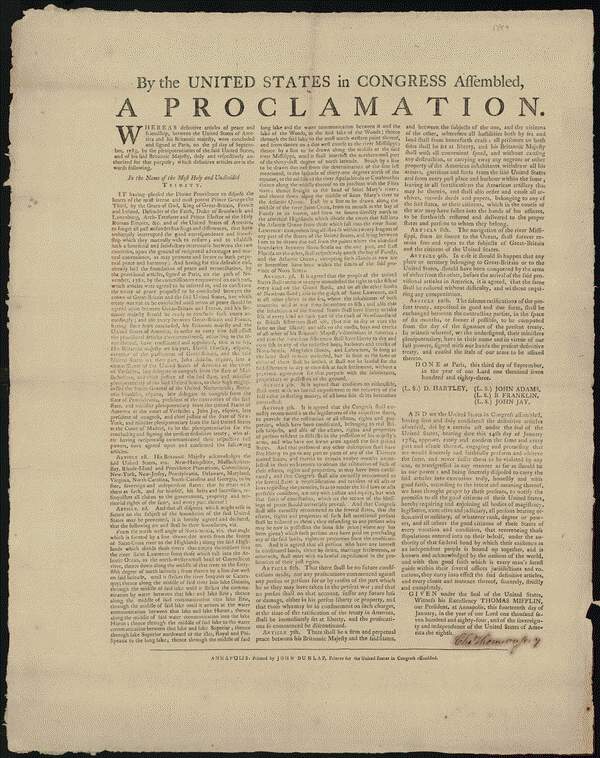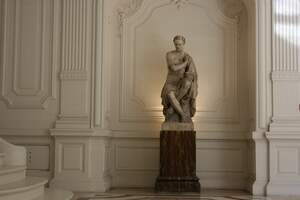

Ratification Day
On January 14, 1784, the Confederation Congress—which was also still known as the Continental Congress—ratified the Treaty of Paris, the document that officially ended the American Revolutionary War and made the United States of America a sovereign nation. This historic event and its anniversary each year is known as Ratification Day. There was a long road between the ending of hostilities of the Revolutionary War and this moment, and the treaty still had to be approved in Paris following Ratification Day, but it was on this day that the United States Congress made the end of the war official.
On April 11, 1783, Congress issued a proclamation declaring a "cessation of arms" with Great Britain, which was approved by Congress four days later. Representatives from Great Britain and the United States signed the Treaty of Paris on September 3, 1783, which said that the United States was "free, sovereign and independent." Furthermore, it said Britain would remove troops from occupied American territory in a timely fashion, that Britain agreed to boundaries that would double the size of the United States' territory, and that the United States would regain access to the cod and haddock fisheries in the North Atlantic that had been taken by Britain during the war. Although the treaty had been signed, it needed to be ratified by Congress as well as by Britain in order to become official.
On December 13, 1783, Congress convened at the Maryland State House in Annapolis, Maryland, to approve the Treaty of Paris. According to the Articles of Confederation, the law of the land at the time, a two-thirds majority was needed to approve the treaty, meaning nine out of the thirteen states had to ratify it. At least two delegates from each state needed to be present in order for that state to vote on the treaty. The two countries were to exchange their ratifications by March 3, 1784.
The winter of 1783-1984 was especially brutal, replete with extreme cold, ice storms, and blizzards, allowing only seven of the thirteen states the ability to convene the required number of delegates until mid-January. Only one delegate from New Hampshire and South Carolina had made it there, so they could not vote. No delegates from New York, Connecticut, New Jersey, and Georgia were present, so they could not vote either.
A faction of the delegates thought that the seven present states could ratify the treaty, since the Articles of Confederation said that a two-thirds majority was needed to enter a treaty, not to ratify it. It looked unlikely that delegates from nine states would arrive in time to ratify it, and this faction thought they should proceed with those seven present. The other faction, led by Thomas Jefferson, thought all nine states needed to be present for ratification. They thought that if they did not follow this, Britain would find out and then have an excuse to nullify the treaty.
Jefferson headed a compromise committee that included members of both factions. They decided that if only seven states were present, Congress would pass a resolution that said that the states present were unanimous in favor of ratifying but weren't sure of their competency to ratify with just seven states. This would be sent to Benjamin Franklin, the American Ambassador to France, who would request a three-month delay from Britain, so that ratification could be done by nine states. But if the three-month delay wasn't granted, Franklin was to present the seven state ratification.
This compromise became moot, as delegates arrived at the last moment. On January 13, two delegates arrived from Connecticut, giving that state the right to vote on the treaty, and bringing the total number of states that could vote to eight. One delegate also arrived from New Jersey. The following day, Richard Beresford of South Carolina arrived, a second delegate from that state and the vote could be taken. On January 17, 1784—Ratification Day—the United States Congress ratified the Treaty of Paris.
A Proclamation of Peace, written by Thomas Jefferson, was also approved on the day. It included a reprinting of the peace treaty as well as words "requiring and enjoining" all of those in positions of power and citizens of the country to observe it. A resolution was also passed that encouraged the state legislatures to pursue a conciliatory approach toward loyalists.
Three packets including a copy of the ratified treaty, the Proclamation of Peace, and the resolution for the state legislatures were sent to Paris via separate couriers. Colonel Josiah Harmar and David S. Franks took separate packets to New York City. They left the port on separate ships, but were not able to embark until February 21, because there was an ice barrier between Long Island and Staten Island. This meant they assuredly would not reach Paris by the March 3 deadline. Harmar reached Europe first, arriving on March 25, at L'Orient, a naval base in Brittany, France. He left for Paris and traveled day and night, arriving at Benjamin Franklin's residence in Passy, on the outskirts of the city, on March 29, and handed him the ratification documents.
Although the ratified treaty arrived after the March 3 deadline, Great Britain accepted the explanation that there had been a delay because of treacherous weather. King George III then signed the British ratification on April 9. Ratifications were exchanged on May 12, 1784, which formally put the Treaty of Paris into effect. Benjamin Franklin sent the British copy to Congress.
The implementation of the Treaty of Paris hinged on its ratification by the United States Congress, an objective that was fulfilled on January 14, 1784. Today, on the anniversary of ratification, we mark Ratification Day. The Old Senate Chamber in the Maryland State House, where the ratification took place, looks exactly as it did on that historic day, and each year on the anniversary a ceremony is held there. At the time of ratification, the United States flag had twelve stars shaped in a circle and a thirteenth inside of the circle. This flag is now flown over the statehouse and over other buildings in Annapolis on Ratification Day.
How to Observe Ratification Day
The following are a few ideas on how to observe Ratification Day:
- Read the text of the Proclamation of Peace, which includes the text of the Treaty of Paris. You could also view a facsimile of the document.
- Visit the Maryland State House, where an event is held each year. Make sure to stop in the Old Senate Chamber, where the ratification of the treaty took place.
- Fly the same style of flag that flew over the statehouse on the day of ratification, and which is still flown there on Ratification Day each year.
- Visit the Museum of the American Revolution.





















